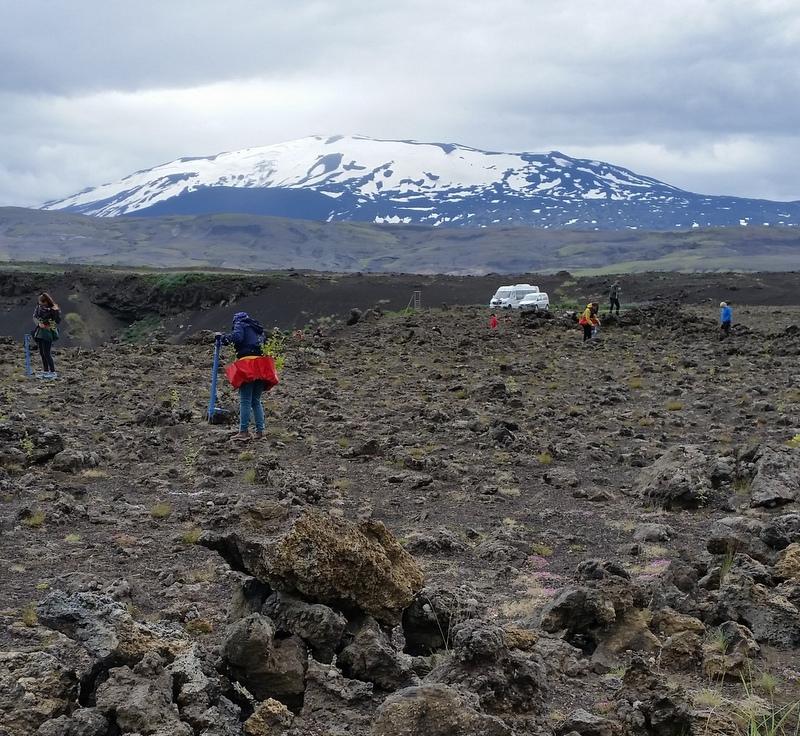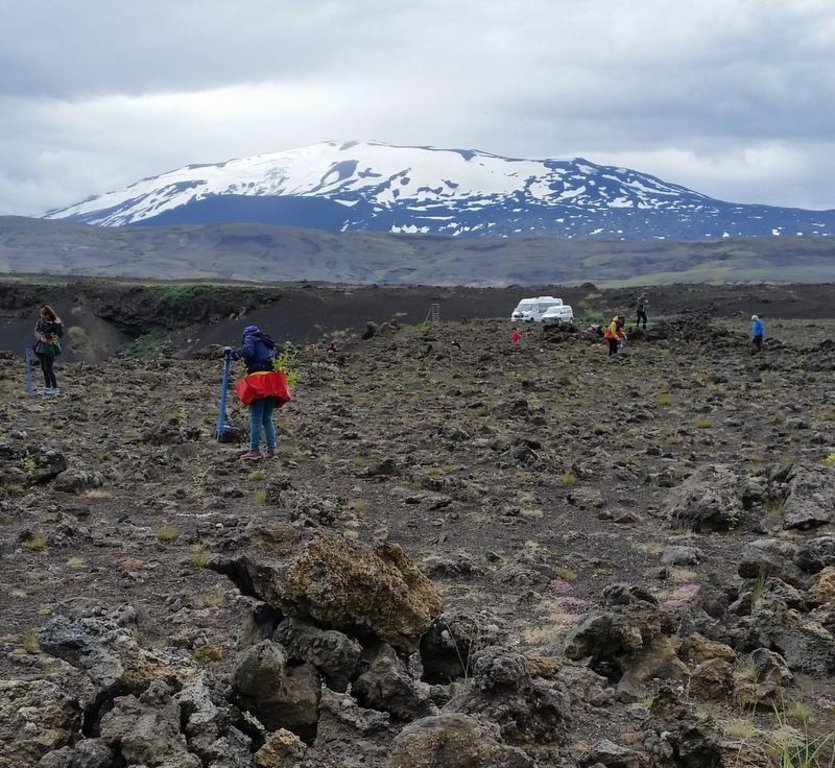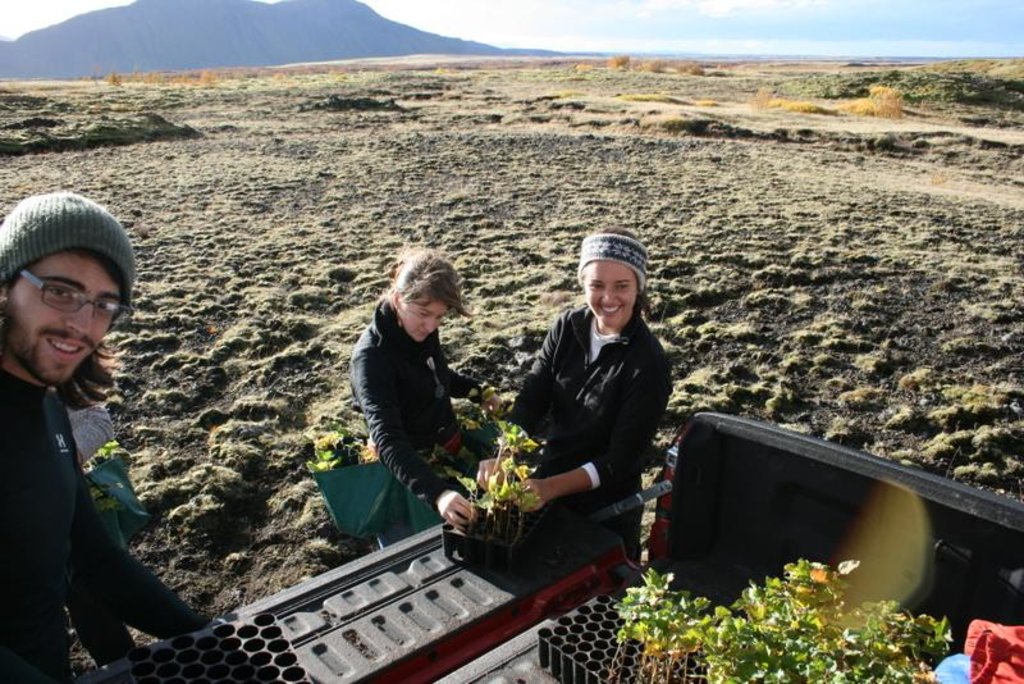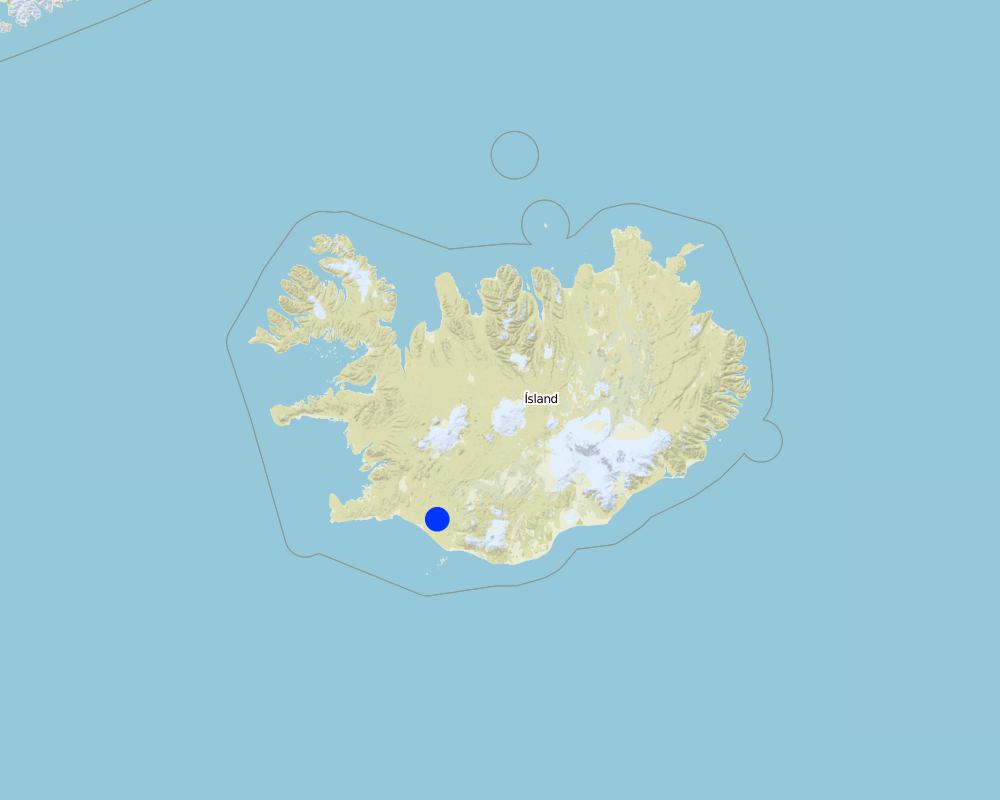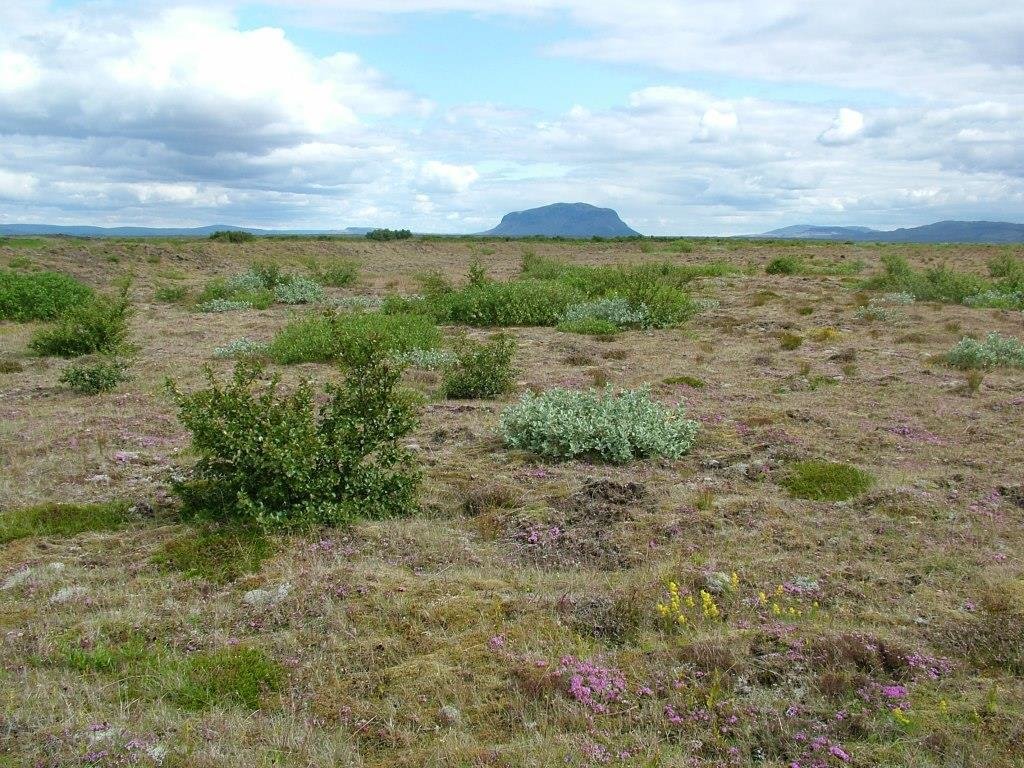Planting trees to establish local seed banks [冰岛]
- 创建:
- 更新:
- 编制者: Thorunn Petursdottir
- 编辑者: –
- 审查者: Fabian Ottiger, Alexandra Gavilano
technologies_1672 - 冰岛
查看章节
全部展开 全部收起1. 一般信息
1.2 参与该技术评估和文件编制的资源人员和机构的联系方式
有助于对技术进行记录/评估的项目名称(如相关)
Preventing and Remediating degradation of soils in Europe through Land Care (EU-RECARE )有助于对技术进行记录/评估的机构名称(如相关)
Soil Conservation Service of Iceland (Soil Conservation Service of Iceland) - 冰岛1.3 关于使用通过WOCAT记录的数据的条件
编制者和关键资源人员接受有关使用通过WOCAT记录数据的条件。:
是
2. SLM技术的说明
2.1 技术简介
技术定义:
The technology is supposed to increase afforestation with native species within the area by supporting natural seed dispersal
2.2 技术的详细说明
说明:
Planting areas are pre-selected based on local condition and optimal rate of potential seed dispersal (prevailing dry-wind direction, distance to remnant seed banks etc.). The areas are partially vegetated or have previously been treated with fertilizer (and seed) to facilitate surface stabilization, improved soil qualities and vegetation succession. Only native species are planted in these seed bank "islands"; mainly birch and a mixture of willow species. The islands/patches are scattered over the restoration area in order to get as much effectiveness out of the technology in the long run.
Purpose of the Technology: The purpose with the technology is to halt further land degradation and facilitate natural succession within the area undergoing restoration. In the long-term, it should substantially reduce wind and water erosion. It should also lead to increased biodiversity, enhanced water availability and accelerated carbon sequestration (in soil and vegetation). The overall restoration task is to increase the resilience of the ecosystems against natural hazards; such as volcanic activities.
Establishment / maintenance activities and inputs: For the first years, the plants in the seed banks islands are yearly treated with a small amount of fertilizer. The nutrient level within the areas is still very low and hardly enough to support sufficient annual plant growth.
Natural / human environment: In the long-term, the technology is expected to substantially increase biomass production, re-build soil qualities, accelerate carbon sequestration and secure water availability within the rangeland and the adjacent ecosystems. Increased tree and diverse vegetation cover will reduce and even halt the sand drift that still creates challenges for inhabitants in adjacent villages, on farmsteads and within the summerhouse clusters, scattered around the area. As the degraded rangeland is in the vicinity of an active volcano (Mt Hekla) the technology is also expected to increase ecosystem resilience against natural hazards like ash and pumice drift and reduce potential offsite damages caused by these materials.
2.3 技术照片
2.5 已应用该技术的、本评估所涵盖的国家/地区/地点
国家:
冰岛
区域/州/省:
Rangarthing Ytra
有关地点的进一步说明:
Rangarvellir
注释:
Total area covered by the SLM Technology is 900 km2.
Map
×2.6 实施日期
如果不知道确切的年份,请说明大概的日期:
- 10-50年前
2.7 技术介绍
详细说明该技术是如何引入的:
- 在实验/研究期间
3. SLM技术的分类
3.1 该技术的主要目的
- 减少、预防、恢复土地退化
- 保护生态系统
- 保持/提高生物多样性
3.2 应用该技术的当前土地利用类型

森林/林地
产品和服务:
- 自然保持/保护
- 娱乐/旅游
- 自然灾害防护

不毛之地
具体说明:
Wastelands, deserts, glaciers, swamps, recreation areas, etc
注释:
Major land use problems (compiler’s opinion): Vast parts of the area are heavily degraded due to unsustainable land use through the centuries in combination to harsh climate and frequent volcanic eruptions. The major land use problem are related to the fact that the concerned ecosystems collapsed long time ago and despite all restoration efforts implemented within the area for over 100 years, the systems are still highly dysfunctional. Their carrying capacity is limited and even light livestock grazing can keep further vegetation succession down. Passive restoration might take place where the livestock grazing has been excluded but in most cases some technologies are needed to "kickstart" the ecosystem and break their negative resilience against changes.
Major land use problems (land users’ perception): They are fully aware that the ecosystems are in a poor condition and restoration is needed in order to push improvements forward. They acknowledge that grazing of collapsed ecosystems can maintain the dysfunctional of the systems and hinder ecological improvements. Nevertheless, in many cases they believe the harsh climate and volcanic activities are the main contributors to land degradation - that livestock grazing and the grazing carrying capacity of the rangeland are not fundamental issues in this context.
Future (final) land use (after implementation of SLM Technology): Forests / woodlands: Fn: Natural
Constraints of wastelands / deserts / glaciers / swamps
Number of growing seasons per year: 1
Longest growing period from month to month: June to end August
3.3 由于技术的实施,土地使用是否发生了变化?
由于技术的实施,土地使用是否发生了变化?:
- 是(请在技术实施前填写以下有关土地利用的问题)

不毛之地
具体说明:
Wastelands, deserts, glaciers, swamps, recreation areas, etc
3.6 包含该技术的可持续土地管理措施

植物措施
- V1:乔木和灌木覆盖层

管理措施
- M1:改变土地使用类型
注释:
Main measures: vegetative measures, management measures
Type of vegetative measures: aligned: -against wind, scattered / dispersed
3.7 该技术强调的主要土地退化类型

生物性退化
- Bc:植被覆盖的减少
- Bq:数量/生物量减少
- Bs:质量和物种组成/多样性的下降

水质恶化
- Hs:地表水良变化
- Hg:地下水/含水层水位的变化
注释:
Secondary types of degradation addressed: Bc: reduction of vegetation cover, Bq: quantity / biomass decline, Bs: quality and species composition /diversity decline, Hs: change in quantity of surface water, Hg: change in groundwater / aquifer level
Main causes of degradation: deforestation / removal of natural vegetation (incl. forest fires), over-exploitation of vegetation for domestic use, overgrazing, Heavy / extreme rainfall (intensity/amounts), wind storms / dust storms, other natural causes (avalanches, volcanic eruptions, mud flows, highly susceptible natural resources, extreme topography, etc.) specify
Secondary causes of degradation: disturbance of water cycle (infiltration / runoff), change in temperature, floods, land tenure, governance / institutional
3.8 防止、减少或恢复土地退化
具体数量名该技术与土地退化有关的目标:
- 减少土地退化
- 修复/恢复严重退化的土地
注释:
Main goals: mitigation / reduction of land degradation, rehabilitation / reclamation of denuded land
Secondary goals: prevention of land degradation
4. 技术规范、实施活动、投入和成本
4.1 该技术的技术图纸
技术规范(与技术图纸相关):
An example showing the development of a local seed bank at a previously eroded area.
Location: South Iceland
Technical knowledge required for field staff / advisors: high
Technical knowledge required for land users: moderate
Main technical functions: improvement of ground cover, increase of surface roughness, improvement of topsoil structure (compaction), increase in organic matter, increase in nutrient availability (supply, recycling,…), increase of infiltration, increase / maintain water stored in soil, increase of groundwater level / recharge of groundwater, water harvesting / increase water supply, water spreading, improvement of water quality, buffering / filtering water, sediment retention / trapping, sediment harvesting, reduction in wind speed, increase of biomass (quantity)
Secondary technical functions: control of raindrop splash, control of dispersed runoff: retain / trap, control of dispersed runoff: impede / retard, control of concentrated runoff: impede / retard, control of concentrated runoff: drain / divert, stabilisation of soil (eg by tree roots against land slides), promotion of vegetation species and varieties (quality, eg palatable fodder), spatial arrangement and diversification of land use
Aligned: -against wind
Vegetative material: T : trees / shrubs
Scattered / dispersed
Vegetative material: T : trees / shrubs
Trees/ shrubs species: birch and several willow species planted to facilitate natural regeneration of native trees and shrubs
Change of land use type: Protected from sheep grazing
作者:
Áskell Þórisson
4.2 有关投入和成本计算的一般信息
其它/国家货币(具体说明):
ISK
如相关,注明美元与当地货币的汇率(例如1美元=79.9巴西雷亚尔):1美元=:
112.0
4.3 技术建立活动
| 活动 | 时间(季度) | |
|---|---|---|
| 1. | Planting seedlings | |
| 2. | Planting |
4.4 技术建立所需要的费用和投入
| 对投入进行具体说明 | 单位 | 数量 | 单位成本 | 每项投入的总成本 | 土地使用者承担的成本% | |
|---|---|---|---|---|---|---|
| 劳动力 | Planting | h | 1.0 | 68.0 | 68.0 | |
| 植物材料 | Seedlings | ha | 1.0 | 3400.0 | 3400.0 | |
| 技术建立所需总成本 | 3468.0 | |||||
| 技术建立总成本,美元 | 30.96 | |||||
4.7 影响成本的最重要因素
描述影响成本的最决定性因素:
The most determinate factors affecting the cost are a) the distance from the farmsteads to the eroded areas and b) the time it takes to plant the seedlings; easily accessible areas vs difficult areas
5. 自然和人文环境
5.1 气候
年降雨量
- < 250毫米
- 251-500毫米
- 501-750毫米
- 751-1,000毫米
- 1,001-1,500毫米
- 1,501-2,000毫米
- 2,001-3,000毫米
- 3,001-4,000毫米
- > 4,000毫米
农业气候带
- 半湿润
- 半干旱
Thermal climate class: boreal
Thermal climate class: polar/arctic
5.2 地形
平均坡度:
- 水平(0-2%)
- 缓降(3-5%)
- 平缓(6-10%)
- 滚坡(11-15%)
- 崎岖(16-30%)
- 陡峭(31-60%)
- 非常陡峭(>60%)
地形:
- 高原/平原
- 山脊
- 山坡
- 山地斜坡
- 麓坡
- 谷底
垂直分布带:
- 0-100 m a.s.l.
- 101-500 m a.s.l.
- 501-1,000 m a.s.l.
- 1,001-1,500 m a.s.l.
- 1,501-2,000 m a.s.l.
- 2,001-2,500 m a.s.l.
- 2,501-3,000 m a.s.l.
- 3,001-4,000 m a.s.l.
- > 4,000 m a.s.l.
5.3 土壤
平均土层深度:
- 非常浅(0-20厘米)
- 浅(21-50厘米)
- 中等深度(51-80厘米)
- 深(81-120厘米)
- 非常深(> 120厘米)
土壤质地(表土):
- 粗粒/轻(砂质)
表土有机质:
- 中(1-3%)
- 低(<1%)
如有可能,附上完整的土壤描述或具体说明可用的信息,例如土壤类型、土壤酸碱度、阳离子交换能力、氮、盐度等。:
Soil fertility is very low-low to medium
Soil drainage/infiltration is poor to medium
Soil water sotrage capacity is very low to medium
5.4 水资源可用性和质量
水质(未处理):
良好饮用水
5.5 生物多样性
物种多样性:
- 低
5.6 应用该技术的土地使用者的特征
生产系统的市场定位:
- 生计(自给)
个人或集体:
- 团体/社区
性别:
- 女人
- 男人
说明土地使用者的其他有关特征:
Land users applying the Technology are mainly common / average land users
Population density: < 10 persons/km2
5.7 应用该技术的土地使用者使用的平均土地面积
- < 0.5 公顷
- 0.5-1 公顷
- 1-2 公顷
- 2-5公顷
- 5-15公顷
- 15-50公顷
- 50-100公顷
- 100-500公顷
- 500-1,000公顷
- 1,000-10,000公顷
- > 10,000公顷
这被认为是小规模、中规模还是大规模的(参照当地实际情况)?:
- 小规模的
6. 影响和结论性说明
6.1 该技术的现场影响
社会经济效应
水资源可用性和质量
饮用水的可用性
家畜用水的可用性
家畜用水的质量
其它社会经济效应
Land price/lease
社会文化影响
文化机会
娱乐机会
社区机构
国家机构
SLM/土地退化知识
生态影响
水循环/径流
水量
水质
水的回收/收集
地表径流
多余水的排放
地下水位/含水层
蒸发
土壤
土壤水分
土壤覆盖层
土壤流失
养分循环/补给
土壤有机物/地下C
生物多样性:植被、动物
生物量/地上C
植物多样性
动物多样性
栖息地多样性
减少气候和灾害风险
碳和温室气体的排放
风速
6.2 该技术的场外影响已经显现
水资源可用性
下游洪水
下游淤积
缓冲/过滤能力
风力搬运沉积物
对邻近农田的破坏
对公共/私人基础设施的破坏
6.3 技术对渐变气候以及与气候相关的极端情况/灾害的暴露和敏感性(土地使用者认为的极端情况/灾害)
渐变气候
渐变气候
| 季节 | 增加或减少 | 该技术是如何应对的? | |
|---|---|---|---|
| 年温度 | 增加 | 好 |
气候有关的极端情况(灾害)
气象灾害
| 该技术是如何应对的? | |
|---|---|
| 局地风暴 | 好 |
气候灾害
| 该技术是如何应对的? | |
|---|---|
| 干旱 | 不好 |
水文灾害
| 该技术是如何应对的? | |
|---|---|
| 比较和缓的(河道)洪水 | 好 |
其他气候相关的后果
其他气候相关的后果
| 该技术是如何应对的? | |
|---|---|
| 缩短生长期 | 好 |
6.4 成本效益分析
技术收益与技术建立成本相比如何(从土地使用者的角度看)?
短期回报:
积极
长期回报:
非常积极
技术收益与技术维护成本/经常性成本相比如何(从土地使用者的角度看)?
短期回报:
非常积极
长期回报:
非常积极
链接和模块
全部展开 全部收起链接
无链接
模块
无模块


